David Suzuki's Blog, page 60
August 6, 2015
Cecil the lion's killing shines spotlight on barbaric trophy hunting
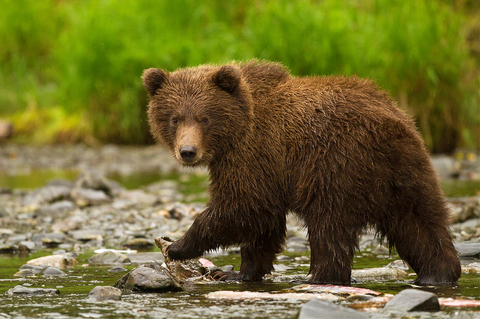
(Credit: Stephen Oachs via Flickr)
A beloved animal, tagged for tracking by researchers, crosses the invisible boundary between protected and unprotected area and is killed by a hunter who has paid tens of thousands of dollars for the "experience". That was the fate of Zimbabwe's Cecil the lion, whose killing sparked torrents of online and on-air outrage. But it also happens around the world every day, including in my home province of B.C.
Many people are familiar with Cecil's story. Minnesota dentist Walter Palmer and his guides, hunting at night with spotlights, are alleged to have tied a dead animal to their car near Hwange National Park to lure the lion. According to reports, Palmer wounded Cecil with an arrow, then tracked and shot the animal with a rifle 40 hours later. The lion's body was found on the park's outskirts, skinned and headless, along with the tracking collar.
Killing animals solely for "sport" or "trophies" is an ongoing and worldwide practice, and something Palmer had engaged in many times and in many places, including Canada. He was even convicted of charges related to an illegal bear kill in 2008.
Closer to home, a grizzly that was tagged for research in Banff National Park had the misfortune to cross from Alberta, where grizzly hunting is illegal, into B.C., where it isn't, and was legally shot and killed. On the B.C. coast, people were outraged when a photo surfaced of NHL player Clayton Stoner with a grizzly he shot in the Great Bear Rainforest. Coastal First Nations have banned trophy hunting there, but the government doesn't recognize the ban. The bear, named Cheeky by local residents, was skinned and had his head and paws cut off, with the rest of the carcass left to rot. Reports have also surfaced that the winner of the in 2012.
Even though many grizzly populations are vulnerable and close to 90 per cent of British Columbians, including many food hunters, oppose trophy hunting, B.C.'s government refuses to end the hunt, even in parks and areas where First Nations have banned the practice. Conservationists and other experts have challenged government population estimates, claiming they're based on guesswork and that the real number is likely less than half the 15,000 on which the government justifies the hunt.
Large carnivores like lions, grizzlies and leopards that are targeted by big-game hunters are extremely vulnerable despite their size and ferocity. They range over large areas, which often puts them in conflict with humans and our infrastructure. Parks and protected areas are too small to provide adequate habitat, so bears often wander into areas where they can be killed by hunters or vehicles. They also reproduce later in life, infrequently, and their young often have low survival rates, so populations don't recover quickly when overhunted.
Large carnivores are also keystone species that play a crucial role in the food web by helping to regulate prey populations. B.C. grizzlies also contribute to rainforest growth by dragging salmon carcasses into the woods, where the fish remains and bear scat provide fertilizer. In B.C., trophy hunters have slaughtered more than 12,000 grizzlies over the past three decades. Like Palmer, non-resident hunters here pay large amounts of money to "bag" a grizzly because the species is protected in their home country, such as the U.S., or because populations have dwindled to a handful, as in Western Europe, where the species is now protected.
Killing animals purely for the "thrill" is barbaric and wasteful, and can't be justified on economic or conservation grounds. Studies show more money can be made from people who want to view and photograph them. Research also shows very little money paid by trophy hunters benefits the local economy.
We're at a critical moment in human history: our population, technology, consumptive demand and global economy are overwhelming the planet's life-support systems -- air, water, soil and other species. We're in a global eco-crisis that demands a redefinition of our relationship with plants and other animals.
It's time to end trophy hunting. In B.C., the government must listen to citizens and conservationists, respect First Nations laws and customs and end the grizzly hunt.
Hey! Want more DSF? Join David Suzuki on Facebook

Why gardening with native plants is the best
Gardening with flowers, shrubs and trees that are native to your area has many advantages. Here are five reasons to add more native plants to your yard or balcony.
1. NATIVE PLANTS REQUIRE LESS WATERING: Using plants adapted to your local climate means less watering, especially in drought-prone areas and during the crazy heat waves many of us have been experiencing the past several years. Native plants are species that have adapted to native insects and soils, so they generally don't need chemical pesticides and fertilizers to protect and feed them.
2. NATIVE PLANTS ARE BEST FOR LOCAL BEES AND BUTTERFLIES: Birds use native plants for food, like seeds and berries, and shelter. Native plants also attract many insects, which pollinate your flowers and are an important food source for birds. Butterflies rely on specific native host plants as larval hosts; many butterfly caterpillars will only eat a few species of plants.
3. NATIVE PLANTS TRUMP INVASIVES: Gardening with native plants can prevent the introduction and spread of invasive plant species in your yard and garden. Many invasive species have been intentionally introduced as gardening plants. Unfortunately, the same characteristics that make a low-maintenance garden plant -- hardy, fast-growing and easy to care for -- often allow that plant to grow in natural areas and replace native vegetation.
4. NATIVE GARDENS ARE UNIQUE: Most people head to their local garden centre and buy the same types of flowers and shrubs no matter where they live. While this makes it easier for big box retailers to uniformly stock their shelves, this is why gardens across the country often end up looking the same. Choosing native plants allows you to appreciate the unique landscape of your area, whether it's a colourful prairie in the summer or woodland ephemerals in the spring.
5. NATIVE PLANTS ARE HANDY: Native plants can be used in virtually any style of garden, from a formal modern landscape to a country cottage garden. In many parts of the country, you can even replace your lawn with native grasses that hardly ever need to be mowed!
So, how do you get started?
Go for a walk and see what grows in nearby natural areas. Grab a wildflower guide or take photos and do some detective work online when you get home. Local conservation and horticultural groups often have helpful tips and resources.
Then visit a local nursery that specializes in native plants. To find one close to you, check out the North American Native Plant Society's list. If your local garden centres don't carry native plants, ask them to start stocking them on their shelves next spring.
And remember, native plants aren't only the best for you and your garden, they're BFFs for all of the butterflies, bees and birds that visit your yard.
Hey! Want more DSF? Join David Suzuki on Facebook

Contribute now to B.C. Climate Action Plan 2.0
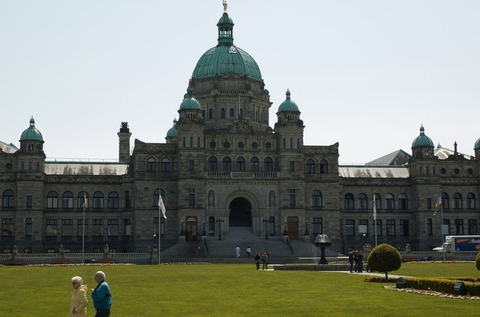
(Credit: Cindy Andrie via Flickr)
Canadian voters can take action on climate change this fall by electing politicians who present strong, long-term plans to cut carbon pollution. Those who live in B.C. have an extra opportunity to be heard in a direct and important way.
The B.C. government is developing a rebooted climate action strategy. The first step of the "Climate Action 2.0" policy-making process is to give B.C. residents the chance to share their priorities with government concerning this globally important issue. Until August 17, B.C. residents are invited to fill out this survey. The David Suzuki Foundation has submitted a response calling for action that will help the province become a global climate leader. You can do the same.
To that end, we invite B.C. residents to attend our webinar on Wednesday, August 12, at 12:15 p.m. Hosted by David Suzuki Foundation Climate and Clean Energy Policy Analyst Kyle Aben, this will be your opportunity to ask questions and learn about the submission process.
If you wish to attend the webinar or receive a recording once it is complete, please RSVP here: https://www.surveymonkey.com/s/JVC2FWG
We encourage B.C. residents to outline their own personal views in their responses, but we are happy to provide our own submission as an example. The Foundation's submission can be viewed below:
Introduction:
Climate change is a present reality, not a future prediction. Strong actions from all levels of government are needed to address this global challenge. An effective suite of polices with dedicated targets can provide the impetus for the shift to a low-carbon economy in B.C. and beyond. The David Suzuki Foundation is responding to the B.C. government's discussion paper in the format requested but is also including specific policy options that will support the achievement of ambitious near- and long-term goals.
Questions from discussion paper:
1) In the short term, which of the four goals needs the most immediate attention in order for B.C. to achieve its 2020 targets? Why?
In the short term, the goals for "the way we travel" should be the most immediate priorities. Transportation makes up 37.2 per cent of B.C.'s total emissions and must be addressed to meet short- and long-term legislated goals. Government must support the shift to zero-emission vehicles to reach the 2020 target. Policies to support this shift are identified later in this document.
2) In the long term, which of the four goals needs the most immediate attention in order for B.C. to achieve its 2050 targets? Why?
In the long term, the province will be required to use all the tools at its disposal to meet the 2050 reduction goals. Nonetheless, the goals for "the way we work" and "what we value" will require the most immediate attention. If B.C. does not make binding commitments, climate action may suffer. The consideration of issues like liquefied natural gas industry expansion must also include the climate costs and risks, and not just the financial benefits.
Goals
The way we live
Goal 1: Communities are thriving and resilient in the face of climate change.
Indicate your level of support for each of the following statements as they relate to achieving Goal 1 (distribute 10 points among 4 choices):
Minimizing travel and energy use needs to be a priority for community planning (4 of 10).
Regulations and incentives should require more energy-efficient buildings and greater uptake of clean energy technologies (3 of 10).
Governments need to invest more in building resilience to extreme weather events and provide stronger direction regarding appropriate places to build (2 of 10).
Local food supply and low-carbon businesses should be strongly supported by communities (1 of 10).
What is the most important statement of the four related to attaining Goal 1? Why?
Community planning to minimize travel and energy use should be the top priority. Minimizing travel and energy use has inherent health benefits and cost savings and brings communities together. Municipalities are already leading climate action in B.C. Let's empower them to do even more and keep the momentum going. The B.C. government should focus on where it has jurisdiction to empower communities. Key priorities include:
Securing long-term dedicated revenue sources (for provincial and municipal contributions) to fund transit and active transportation infrastructure and services.
Community Charter. All provincial transit investment agreements should be based on local communities aligning their planning targets to support compact communities.
Seek to increase the density of housing areas, thereby creating walkable and bikeable communities with amenities and services nearby.
The way we travel
Goal 2: People and goods move efficiently and reliably, using clean transportation.
Indicate your level of support for each of the following statements as they relate to achieving Goal 2 (distribute 10 points among 4 choices):
Increasing use of clean, coordinated transportation such as public transit, carpooling, shared travel, bicycles and walking should be a government priority (3 of 10).
People should be encouraged to drive less through incentives or increased costs (e.g. for using fossil fuels) (2 of 10).
Regulations and incentives should be expanded to increase the use of cleaner vehicles and fuels (4 of 10).
Public and private investments should be directed towards infrastructure designed to withstand extreme weather conditions (1 of 10).
What is the most important statement of the four related to attaining Goal 2? Why?
Efforts to increase the use of cleaner vehicles and fuels should be the top priority. Expanding public transportation networks and encouraging people to drive less are also important goals, but many people do not have the option to take public transit or drive less. The commercial transportation sector accounts for 23.9 per cent of B.C.'s emissions and increasing public transit or having people drive less does not reduce emissions in this sector. Cleaner vehicles and fuels will be essential in cutting carbon pollution from transportation in B.C.
The way we work
Goal 3: B.C.'s economy remains strong, and jobs continue to be created, while greenhouse gas emissions fall.
Indicate your level of support for each of the following statements as they relate to achieving Goal 3 (distribute 10 points among 5 choices):
Governments, businesses, universities and colleges need to accelerate development of a workforce that excels in a low-carbon economy (2 of 10).
Consumers should use their purchasing power to encourage organizations to reduce their emissions (1 of 10).
Government should use regulations and incentives to drive organizations to innovate and cut their emissions while growing their business (1 of 10).
New major sources of emissions in the province should be required to align with B.C.'s climate plan (2 of 10).
Government and business should collaborate to expand technology exports and access to global carbon markets and investments (2 of 10).
What is the most important statement of the five related to attaining Goal 3? Why?
If B.C. is serious about meeting its long-term emissions-reduction goals, any new major emissions sources must align with B.C.'s climate plan. We can't have individuals, local governments, current business and others make efforts to reduce emissions just to have those efforts cancelled out by emissions from a new industry. New industries must be climate conscious or our 2050 goal will be unattainable.
What we value
Goal 4: The cost of climate change for society is considered whenever British Columbians make important decisions.
Indicate your level of support for each of the following statements as they relate to achieving Goal 4 (distribute 10 points among 4 choices):
Government should expand the use of carbon pricing to stimulate business and consumer decisions that reduce emissions (4 of 10).
Government should improve the affordability of solutions that allow business and consumers to reduce emissions and prepare for climate change (2 of 10).
Government should set targets for types of emissions (e.g. transportation, industry, buildings, etc.) to get reductions (2 of 10).
Government should use regulations and incentives to drive organizations and people to consider costs of adapting to climate change in important decisions (2 of 10).
What is the most important statement of the five related to attaining Goal 4? Why?
Carbon emissions cause climate change. Applying a carbon tax acknowledges this and prices the problem, thereby reducing the "free dumping" of this pollution into our atmosphere. This tax makes cleaner options more economically viable as traditional pollution sources become more costly. A carbon tax is the strongest and most effective tool for mitigating climate change. B.C.'s carbon tax has been cited as a successful example of carbon pricing for the past seven years, and the current freeze should be lifted and tax level increased to meet our emissions-reduction goals.
Summary of climate change policy recommendations for B.C.
Transportation
Transportation improvements reduce emissions and congestion, improve public health and lower transportation costs for government and individuals. Powering our transportation system with clean electricity is key to a climate policy in B.C. Recommendations also include:
Invest in public transit infrastructure.
Review the Renewable and Low Carbon Fuel requirements and set targets for 2050.
Develop a clean emission vehicle standard.
Carbon tax
B.C.'s carbon tax is a success. Fuel use has dropped in the province while it has increased in other parts of Canada, all while economic growth has outpaced the national average. It's time to remove the freeze on annual carbon tax increases and have its positive effects grow even further. Recommendations for the carbon tax include:
Reinstate the annual increases to the carbon tax.
Expand the carbon tax to cover the remainder of B.C.'s economy.
Increase the transparency of tax cuts resulting from the carbon tax.
Green buildings
Buildings account for 12 per cent of B.C.'s emissions. Efforts to retrofit buildings as well as increase efficiency standards for new buildings will be required for substantial emissions reductions in this area. Buildings should be designed to reduce their overall impact on the natural environment and human health. Recommendations for creating more sustainable buildings include:
Promote district energy systems, where possible.
Develop a net-zero building standard and timeframe for implementation.
Promote and provide incentives for the use of wood for construction.
Develop a Property Assessed Clean Energy (PACE) financing system for homeowners.
B.C.'s clean economy
Clean technology is Canada's fastest-growing sector and has quickly developed into one of the most promising elements of our country's economy. B.C.'s cleantech industry has grown to one of the most vibrant in North America with more than 200 companies employing over 8,000 people and generating $2.5 billion in revenues annually, primarily from exports. Recommendations for supporting B.C.'s clean tech economy include:
Strengthen B.C.'s Innovative Clean Energy (ICE) fund.
Expand the Carbon Neutral Capital Program funding.
Have local governments become carbon-neutral by 2018.
Bring "natural capital assets" into the same asset-management system as engineered infrastructure.
Hey! Want more DSF? Join David Suzuki on Facebook

Homegrown rain gardens win Toronto innovation award
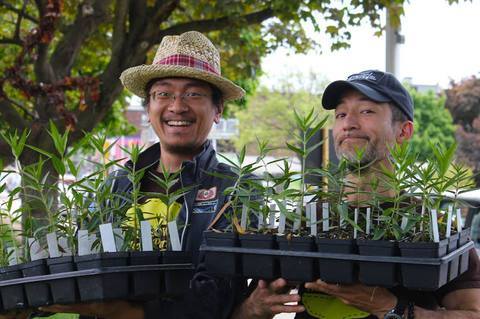
A team of neighbours led by Ranger Marc Yamaguchi planted the first rain garden in Toronto's Danforth East Village in June 2015
Part of the David Suzuki Foundation's Homegrown National Park Project, the Rain Gardens of Danforth East Village is a pilot project that aims to beautify a network of urban yards while making them easier to maintain, more attractive to bees, birds and butterflies, and better able to handle severe storms and extreme heat.
In June, the project won the Toronto Foundation's 2015 Vital Innovation Award, which celebrates and supports ideas with the potential to enhance Torontonians' health and well-being.
The new rain gardens will benefit 10 properties in the City of Toronto's East York-Danforth Village, where homes sit atop generally sandy soils and former waterways that once emptied into Ashbridges Bay. They'll feature locally adapted wildflowers, shrubs and trees that will need little to no watering once established. A landscaped, shallow depression in each yard will naturally absorb and filter stormwater, preventing flooding.
Volunteer Homegrown Park Ranger Marc Yamaguchi and local residents and volunteers planted the first front yard rain garden as part of 100-in-1-day on June 6, 2015. They hope to create a low-maintenance model for other residents to adopt and adapt in their yards across the city.
The Homegrown National Park Project is an effort to re-imagine the city as a National Park, one simple, community-led, green intervention at a time. For more information, visit davidsuzuki.org/homegrown.
Hey! Want more DSF? Join David Suzuki on Facebook

How to go pesticide free in your garden
Did you know more than 90 per cent of the bugs in a garden are beneficial? And these critters and pesticides do not mix well! You can avoid harming the beneficial birds, bees and butterflies by using natural pest control methods. Natural methods are generally safer and less expensive to use than pesticides. And many municipalities in Canada have by-laws restricting cosmetic use of pesticides.
The information below is adapted from the Toronto Region Conservation Authority's great Maintaining Your Pollinator Garden publication.
What is natural pest control?
Natural pest control encompasses any practice used for controlling weeds, pests and diseases in your garden without using chemical products. Use this section as a troubleshooting guide to deal with problems as they arise in your garden. Key principles of natural pest control include:
• Maintaining healthy soil
• Mulching
• Planting a variety of species (keep in clusters but use 10+ species)
• Avoiding overwatering
• Companion planting (pairing species for natural pest resistance)
• Planting native species
• Avoiding overcrowding in the garden
• Practicing good hygiene with garden tools and equipment
Controlling Weeds
An Ounce of Prevention:
• Mulch, Mulch, Mulch! Mulch not only controls weeds but improves soil quality and moisture and protects plant roots, helping to create a healthy, resilient garden.
• Remove seed sources of undesirable plants. Hand-pull or clip back the seed heads of weed plants before they go to seed. This will slowly remove the seedbed of weeds from the garden, inhibiting weeds from coming back in future years. Make sure not to put any weeds that are about to go to seed in the compost.
A Pound of Cure:
• Hand-pull weeds. Make sure to get weeds from the roots by weeding when the soil is moist and pulling from the base of the plant. A trowel can be used to loosen the soil to remove well-rooted weeds.
• Apply soap or acetic acid based herbicides. Make sure to avoid other plants when using these! These products can be found in hardware stores, renovation centres, and agricultural supply stores.
• Smother the problem. For larger areas of weeds, spread thick, dark plastic (heavy duty plastic bags or landscape fabric) over the ground. This works best if the coverings are put down in the early fall and left until you are ready to plant in spring. Leave for at least two months to kill weeds properly.
• Consider leaving certain 'weeds'. So-called weeds like golden rod, Queen Anne's lace, yarrow and common milkweed are highly beneficial to insects, so unless they are taking over your garden, consider leaving them.
Controlling Insects
To discourage undesirable insects from making themselves at home in your garden you may wish to adopt the following gardening practices:
• Select plants that are hardy in your local area.
• Select disease-resistant varieties of plants.
• Avoid overcrowding plants.
• Include as much variety of plant species as possible. Insect infestations tend to get out of control in monoculture environments.
• Examine plants frequently for early signs of insect and disease damage.
Examine leaves, looking on both the surfaces and the undersides. Often, all that is needed is to remove the effected leaves from a plant or give them a squirt of insecticidal soap. Act promptly to gain control of insect pests.
Use Caution
Organic pest controls must be applied carefully to avoid killing the beneficial insects that you are trying to attract to your garden. Insects are a normal part of any garden and some cosmetic damage to plants can be expected. Remember that you are trying to attract pollinators to your garden! In fact, insect damage may be from desirable pollinator species, like the leaf cutter bee that cuts pieces of leaves to use as 'baby blankets' for their young. However, if insects are becoming a serious problem in your garden
there are several organic methods to prevent further damage.
For more information, check out, Maintaining Your Pollinator Garden
Hey! Want more DSF? Join David Suzuki on Facebook

August 5, 2015
When is carbon coloured blue?

(Credit: Alan Harper via Flickr)
By Anu Rao, marine planning specialist
We all know about kitchen sinks, but what about carbon sinks? These are ecosystems that suck greenhouse gases out of the air and store them in plants or in the soil under the plants. The gases stored in aquatic habitats are called blue carbon. When plants photosynthesize, they pull carbon dioxide from the atmosphere and store it in their roots and shoots. When they die and get buried in the sediment-laden water that flows into estuaries, this stored carbon is released through decomposition and captured in estuary soils. These richly organic soils can capture and store up to five times more atmospheric carbon than rainforests, an important function as the effects of climate change become increasingly severe.
Estuaries shelter a variety of species, including salmon before they migrate into the ocean. "Estuaries are one of the most abundant habitats in terms of biodiversity," says Kimberley Armour, Blue Carbon Project Manager with the Squamish River Watershed Society. "They're super, super rich areas and are considered to be the nurseries of the sea."
Estuaries give us places to live and play, as well as to set up industries. They face heavy development pressures, leading many to question incentives for protection.
"You won't find someone who doesn't value the estuary," Armour says, "but that doesn't mean the economy values the estuary. If we can give these areas economic value just for being estuaries, that makes it exciting." The David Suzuki Foundation calculated the value of estuaries for carbon storage and sequestration in our report, Sound Investment: Measuring the Return on Howe Sound's Ecosystem Assets, and concluded they save us approximately $15,000 per year.
Squamish is one of the few communities in B.C. whose stewardship group is collecting data to help the provincial Climate Action Secretariat find ways for people to claim blue carbon offsets in estuaries. Owners of land containing estuary habitat, for example, could sell carbon credits and earn money by protecting rather than developing it.
"There needs to be other layers of protection as well," Armour explains. "But this is another tool in the toolbox to protect these really abundant habitats."
The Squamish project will measure how much carbon is stored in salt marshes in the estuary by mapping the marshes, taking soil samples and analyzing vegetation. It will also raise awareness of how much of the original estuary has been lost due to diversion of the Mamquam and Squamish rivers from their traditional floodplain to allow for ongoing development in downtown Squamish.
The project demonstrates the importance of protecting remaining and increasingly valuable habitats such as estuaries. Disturbing or developing over estuaries not only removes their potential to absorb additional greenhouse gases, but also releases stored carbon back into the atmosphere for up to 10 years.
As more B.C. communities start collecting blue carbon data, provincial methodology will be strengthened. If your community wants to get involved, check out the resources on the Blue Carbon Project page and contact the Squamish River Watershed Society.
Hey! Want more DSF? Join David Suzuki on Facebook

August 4, 2015
10 tips for a monarch-friendly garden
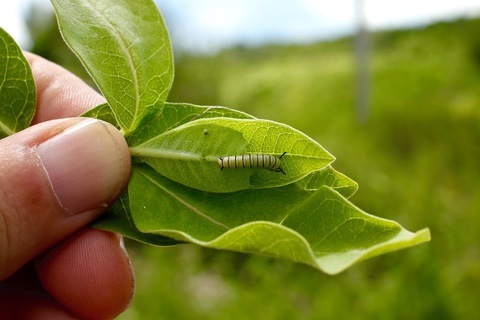
Monarch caterpillar on common milkweed leaf. (Credit: joderoberts via Instagram)
Here are 10 tips for making your garden a happy place for monarch butterflies and countless birds, bees and other important critters.
Start small. You can always enlarge the garden later on as you gain confidence or more people join in.
Get help. Engaging the local community is the key to your success. Educate and involve them; plan for summer help.
Locate the garden in a sunny area. Butterflies and most butterfly-attracting plants need bright sunshine.
Nectar and host plants. Think two kinds of plants: nectar sources and host plants. Butterflies visit flowers in search of nectar to eat so you need to have nectar-producing flowers in your garden. But you also want to have host plants that provide food for caterpillars and that will lure female butterflies to lay eggs on them. Different kinds of butterflies require different host plants.
Think water source. It will be very difficult to keep your garden alive during the summer or periods of drought unless you have an easy water source. Is there a faucet nearby, or can one be created? In the long-term, carrying buckets may not work. Soaker hoses buried in the ground are also a good idea. Mulching the garden will save water and suppress weeds; lawn clippings are good mulch.
Include both annuals and perennials. Use native plants where possible. Both seeds and seedlings of native plants can be purchased locally and planted directly in the garden in either mid-June or late August/early September. Seeds can be started indoors in late winter and transplanted into the garden as seedlings in the spring. Using native plants provides butterflies, insects, birds and mammals of your area a food source they can use throughout the growing season.
Consider having a damp area or shallow puddle in the garden. Some butterflies drink and extract minerals from moist soil. Sometimes large number of butterflies will gather for a drink, "puddling".
Consider placing flat stones in the garden. Butterflies often perch on stones, bare soil or vegetation, spread their wings and bask in the sun to raise their body temperature.
Plan for plants to bloom through the growing season. Butterflies are active from early spring to late fall. Plant a selection of flowers that provide nectar throughout the entire growing season. Remove spent blooms (deadheads) on a regular basis to encourage new flowers and continuous nectar.
Do not use pesticides in or near the garden. Most traditional garden pesticides are toxic to butterflies. Use predatory insects or hand remove pests.
Adapted from Monarch Teacher Network's Monarch Habitat Guide.
Hey! Want more DSF? Join David Suzuki on Facebook

July 30, 2015
What the hake? B.C.'s largest fishery is turning fish into fish meal

Hake: food or feed? (Credit: Artizone via Flickr)
By Scott Wallace, senior research scientist
Few Canadians know that the largest fishery on B.C.'s coast is for Pacific hake. Although it's a food-grade fish, the federal government granted permission last week, for the first time in nearly 30 years, to allow catches to be converted into fish meal.
Hake is a schooling fish related to the more commonly known haddock and cod. The Canadian hake fishery this year is allowed to catch 114,000 metric tonnes, equivalent to about a billion meal servings. Over the past decade most of B.C.'s hake was sold to Russia, but an economic embargo of Canadian products into Russia means B.C.'s hake can't be sold to this market. Because the B.C. hake industry products and market are not diversified, the solution for this year's catch is to sell it to a reduction plant, where food-grade hake is ground to make fish meal, most likely for farmed Atlantic salmon.
Under the Fisheries Act, it is illegal to use fish in this manner unless the fisheries minister grants an exemption. On July 24, Fisheries and Oceans Minister Gail Shea granted such an exemption to the hake fishery, allowing it to convert about half its allocation-- or 55, 000 tonnes (equivalent of roughly 55,000 pickup trucks full of fish) -- into food for other agricultural products.
Although the amount of fish being taken might be sustainable from a biological yield perspective, the conversion of food fish to fish feed is unsustainable in a resource-constrained world where over a billion people live in extreme poverty. While the Ministry of Fisheries and Oceans stated that the exemption is a one-year exceptional measure, we should not permit this type of fishing in Canadian waters under any circumstance. With the price of fish meal continually climbing, converting fish into meal is an increasingly attractive proposition for fisheries -- first hake, then herring, dogfish or any fish that isn't selling in the global market.
Hake stocks are healthy and the fishery is well-managed, with a Marine Stewardship certification issued last year. So does it matter what the end use is? Whether the fish is eaten directly or converted into fish meal and then fed back to another fish will make no difference to the marine ecosystem. Globally, however, direct human consumption of food is the most efficient use in the midst of limited resources. The conversion into fish meal requires additional energy: fossil fuels to grow, produce and transport the end product. The amount of fish being granted an exemption could produce 500 million seafood servings. (Canada health guide suggests that 75 grams of seafood make up a serving.)
Seafood is often seen as a luxury product, but many high-volume global fish products are sold for pennies per kilogram. Pacific hake will be sold at 18 cents a kilogram this summer (compared to halibut, which sells for at least 100 times more).
While it is unfortunate that a sustainable fishery has been economically affected by an international trade issue beyond its control, it does highlight a major problem with how we consume seafood in Canada and in developed countries in general. Hake should be a good bet for Canadian and global seafood markets. The U.S. fishery, which can catch three times as much as Canada's, has a diversified fishery whose products are sold for human consumption. If caught and processed properly, hake is firm and sweet and tasty when prepared with garlic and olive oil.
The minister made the exemption without public discussion. It was opposed by the Nuu-chah-nulth First Nations, who were not consulted despite the federal government's legal obligation to do so.
The future benefits of letting the fish simply swim for a year and contribute to the ecosystem in which the fishery is embedded were never considered. The minister's decision should be revoked and public discussion should be made an essential part of decisions involving these kinds of exemptions.
Please speak up on this issue now »
Hey! Want more DSF? Join David Suzuki on Facebook

Rouge park deserves the same protection as other Canadian parks
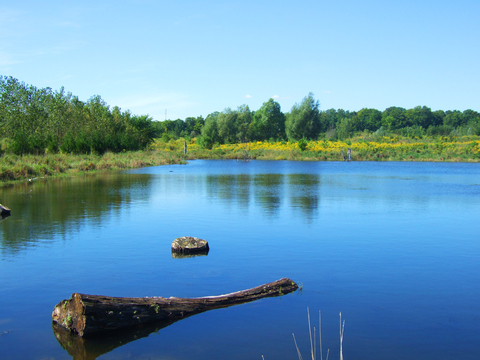
(Credit: kaeko via Flickr)
In fall 2011, politicians, farmers, environmentalists and local advocates met in Toronto to get the ball rolling for Canada's first urban national park, in the Rouge watershed on the city's east side.
It was a remarkably diverse gathering. Senior federal government members, including then Environment Minister Peter Kent, and provincial and municipal politicians from across party lines sat with representatives of farming and environmental groups, and local advocates who have fought for more than 30 years to protect wetlands, farms and forests stretching from the greenbelt to Lake Ontario.
The Rouge, home to more than 1,000 plant and animal species, has a rich Aboriginal, agricultural and ecological history. But proposed and existing urban encroachment, oil pipelines, highways, railways and other infrastructure threaten the park. In some places, pesticides and fertilizers from intensive farming could be adversely affecting biodiversity.
Those attending the inaugural meeting to create Rouge National Urban Park rolled up their sleeves and sharpened their pencils, and by the end of the day had banged out 10 consensus principles to guide its establishment and management. These principles addressed a range of issues, including ensuring progressive governance led by Parks Canada and fostering sustainable farming in the park. Government leaders, stakeholders and experts also identified the importance of ecological health to successful park management. Principle 8 states, "Maintain and improve the ecological health and scientific integrity of the park."
The concept of ecological health or ecological integrity is critical to sound parks management and has been enshrined in best practices for establishment of parks and protected areas worldwide. At its core, it means parks managers must make preserving and restoring nature a top priority. As noted by Anna Baggio of the Canadian Parks and Wilderness Society, "This would mean that if planners wanted to put in a road or parking lot, for example, they would have to do it in a way that has the least harmful impact on the park. The emphasis on putting nature first is particularly important because Rouge National Urban Park is surrounded by heavily populated, urbanized areas."
Despite the widely recognized importance of a nature-first approach for Canada's national parks, federal legislation passed earlier this year to create Rouge Park makes no reference to ecological integrity. Instead, it contains a weak reference to ecosystem health and offers a highly discretionary approach to protecting and restoring nature.
A legal review by Ecojustice concluded that the Rouge legislation offers significantly weaker natural environment protection than either the Canada National Parks Act or Ontario's Provincial Parks and Conservation Reserves Act. Unlike these acts, which prioritize nature, the Rouge legislation only requires that the minister "take into consideration the protection of its natural ecosystems and cultural landscapes and the maintenance of its native wildlife and of the health of those ecosystems."
Because the Rouge legislation falls short of provincial, national and international standards for protected areas, all three federal opposition parties have opposed it, as have . The Ontario government has also said it will not transfer provincial lands to Parks Canada to be added to the park unless the legislation is strengthened. All support the park's creation, just not the flawed act that will govern its management.
Despite their opposition to the current legislation, environmental groups have consistently lauded federal leadership in creating the park, as well as the federal government's recent decision to double its initial contribution by adding 21 square kilometres of federal lands in Pickering and Uxbridge.
The Rouge legislation captures many core values that motivated politicians, stakeholders and local communities to come together to advocate for a national park in the Rouge. And we're almost there. But the legislation must be strengthened if those values are to be effectively taken into account.
Canadians love parks and protected areas and visit them often, especially this time of year. These natural areas protect our country's biological richness and offer Canadians and visitors alike places for respite, solitude in nature and the physical, mental, emotional and spiritual benefits of time spent outdoors.
We owe it to all to ensure that our parks, including Rouge National Urban Park, are supported with strong laws and policies.
Hey! Want more DSF? Join David Suzuki on Facebook

July 29, 2015
Don't feed these fish to farmed salmon! Ask the Fisheries minister to stop exemption for hake fishery.

The hake catch could provide the equivalent of 500 million meals for Canadians. Instead, this valuable protein is feeding unsustainable farmed salmon and other farmed animals. That's not right.
Hey! Want more DSF? Join David Suzuki on Facebook

David Suzuki's Blog
- David Suzuki's profile
- 247 followers



